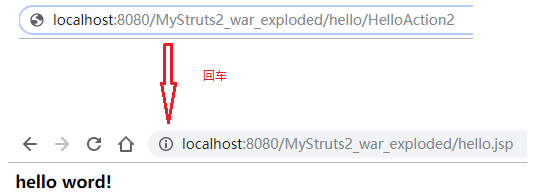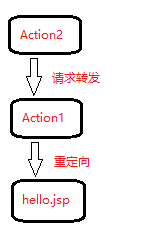1、配置流程
(1)web.xml文件(在web目录下的WEB-INF目录里面):对过滤器进行配置(这里是统一的)
<?xml version="1.0" encoding="UTF-8"?> <web-app xmlns="http://xmlns.jcp.org/xml/ns/javaee" xmlns:xsi="http://www.w3.org/2001/XMLSchema-instance" xsi:schemaLocation="http://xmlns.jcp.org/xml/ns/javaee http://xmlns.jcp.org/xml/ns/javaee/web-app_4_0.xsd" version="4.0"> <filter> <filter-name>struts2</filter-name><!--不重复即可--> <filter-class>org.apache.struts2.dispatcher.ng.filter.StrutsPrepareAndExecuteFilter</filter-class><!--过滤器类名--> </filter> <filter-mapping> <filter-name>struts2</filter-name> <url-pattern>/*</url-pattern> </filter-mapping> </web-app>
(2)页面部分:用于测试是否能访问到目标页面
<%@ page contentType="text/html;charset=UTF-8" language="java" %> <html> <head> <title>hello</title> </head> <body> <h3>hello word!</h3> </body> </html>
(3)struts.xml:在src目录下
(4)书写Action类:这里统一采用继承ActionSupport类的方式创建Action类
2、请求转发(默认方式)
(1)struts.xml文件配置:
<?xml version="1.0" encoding="UTF-8"?> <!DOCTYPE struts PUBLIC "-//Apache Software Foundation//DTD Struts Configuration 2.0//EN" "http://struts.apache.org/dtds/struts-2.0.dtd"> <struts> <package name="hello" namespace="/hello" extends="struts-default"> <action name="HelloAction" class="pers.zhb.hello.HelloAction" method="execute"> <result name="success" type="dispatcher">/hello.jsp</result> </action> </package> </struts>
result标签内部的属性被定义为请求转发的方式,请求转发为默认的访问方式,即使不配置该属性依旧以请求转发的方式访问hello.jsp
(2)Action类
public class HelloAction extends ActionSupport { public String execute() { return "success"; } }
(3)测试结果

3、重定向
(1)struts.xml配置文件
<struts>
<package name="hello" namespace="/hello" extends="struts-default">
<action name="HelloAction" class="pers.zhb.hello.HelloAction" method="execute">
<result name="success" type="redirect">/hello.jsp</result>
</action>
</package>
</struts>
(2)测试结果:

4、从一个Action请求转发到另外一个Action
(1)struts.xml配置文件:
<struts>
<package name="hello" namespace="/hello" extends="struts-default">
<action name="HelloAction1" class="pers.zhb.hello.HelloAction1" method="execute">
<result name="success" type="redirect">/hello.jsp</result>
</action>
<action name="HelloAction2" class="pers.zhb.hello.HelloAction2" method="execute">
<result name="success" type="chain">
<param name="actionName">HelloAction1</param>
<param name="namespace">/hello</param>
</result>
</action>
</package>
</struts>
其中package和param中的namespace属性的指定的值要保持一致,第一个param中的值为要请求转发到的Action的名称。
(2)创建两个Action:
Action1:
public class HelloAction1 extends ActionSupport { public String execute() { System.out.println("我是HelloAction1!"); return "success"; } }
Action2:
public class HelloAction2 extends ActionSupport { public String execute() { System.out.println("我是HelloAction2!"); return "success"; } }
(3)测试结果:
浏览器:

控制台:

(4)运行流程

5、从一个Action重定向到另外一个Action
(1)struts.xml配置文件:
<struts>
<package name="hello" namespace="/hello" extends="struts-default">
<action name="HelloAction1" class="pers.zhb.hello.HelloAction1" method="execute">
<result name="success" type="dispatcher">/hello.jsp</result>
</action>
<action name="HelloAction2" class="pers.zhb.hello.HelloAction2" method="execute">
<result name="success" type="redirectAction">
<param name="actionName">HelloAction1</param>
<param name="namespace">/hello</param>
</result>
</action>
</package>
</struts>
(2)创建两个Action
(3)测试结果:

(4)访问流程:
